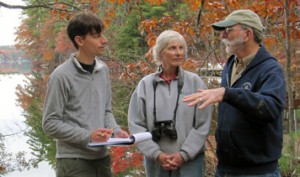Clean Lake Check-Up
There’s no escaping it. Wherever you live in this area of Maine, you are in a lake watershed. Rivers, streams, roadside ditches, and sloped land all feed stormwaters and snowmelt to one lake or another.
Aside from their beauty, the habitats they provide, and the recreational opportunities they give us, lakes are the backbone of the region’s economy. Protecting our lakes is as simple as keeping the natural fertilizer phosphorus out of their waters. Since most of the phosphorus reaching lakes is attached to soil particles, erosion control is the key. Fortunately, fixing or preventing erosion of driveways, roads, ditches, shorelines, parking areas, and homesites is also cost-effective. It lowers maintenance costs.
The Lakes Environmental Association has offered the Clean Lake Check-Up service for many years. A Check-Up involves a site visit to analyze erosion problems and to design measures to prevent or control them. Often these measures result in vegetation plans or some other form of property enhancement. The Check-Up process is based on common sense and the basics can be followed by anyone if a few rules are heeded. Conducting a do-it-yourself Clean Lake Check-Up is a good way to help the downstream or downhill lake, beautify your property, and save the continual costs of maintenance. Here are the basics:
- Start at the top of the property and watch for locations where runoff enters. Wait until a rainstorm for best observation.
- Note the channel(s) that runoff takes as it travels through your property.
- Locate permanent features like buildings, walkways, parking areas, and roadways. Draw a rough site plan showing drainage patterns and permanent features. Usually, problems will be associated with those features.
- Beginning at the highest point on the property, select locations where runoff can be diverted into woods or vegetated areas. Depending on the slope and the area being drained, diversion can be accomplished by a simple berm (speed bump) or may require water bars (open-topped culverts) or even modification of the topography to drain to a ditch(es).
- Wherever concentrated flows leave a diversion, they should feed to a stone-lined pit (sump) with a level overflow rim. Sumps are intended to break the velocity of the water and convert flows leaving the sump from channelizing back into sheet flow to be absorbed by vegetation.
- Breaking up and diverting the runoff to vegetated areas at every point possible is the key to low-cost erosion control. Use every opportunity that the topography allows and think in terms of protecting yourself from a downpour.
- Vegetate or stabilize all “dirt” surfaces possible. Even roadways, particularly those prone to erosion, can be armored with recycled asphalt or crushed rock. Vegetation is your best friend, and non-vegetated areas need to be adequately armored.
- Infiltration ditches around building drip edges will help control runoff from scouring backfill or lawns. These are typically 18 to 24 inches in width and depth and are filled with crushed stone.
- Be sure that any activities within 100 feet of a waterbody are done with proper permits.
- Use common sense as your guide. Once you switch yourself into “erosion control mode” and observe your land with this perspective, a number of relatively easy fixes will occur to you.
We have reached the point where this type of action is essential for keeping our lakes clean. Sediments and stormwater continue to bring phosphorus into lakes in amounts that exceed their carrying capacity. Watershed development is continually opening up new areas that were previously vegetated and stabilized. The cumulative impact of thousands of small activities is beginning to take a toll on our lakes. Check-Ups are a good way of countering this trend.
To request a Clean Lake Check-up, call 647-8580.
